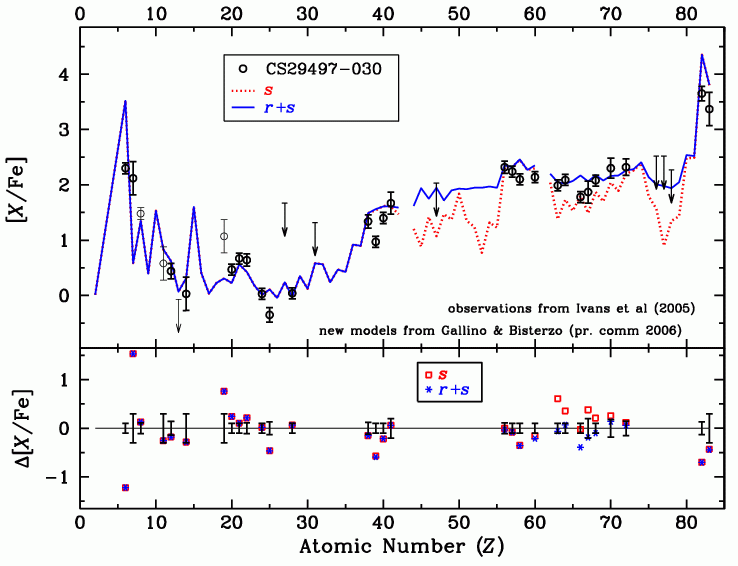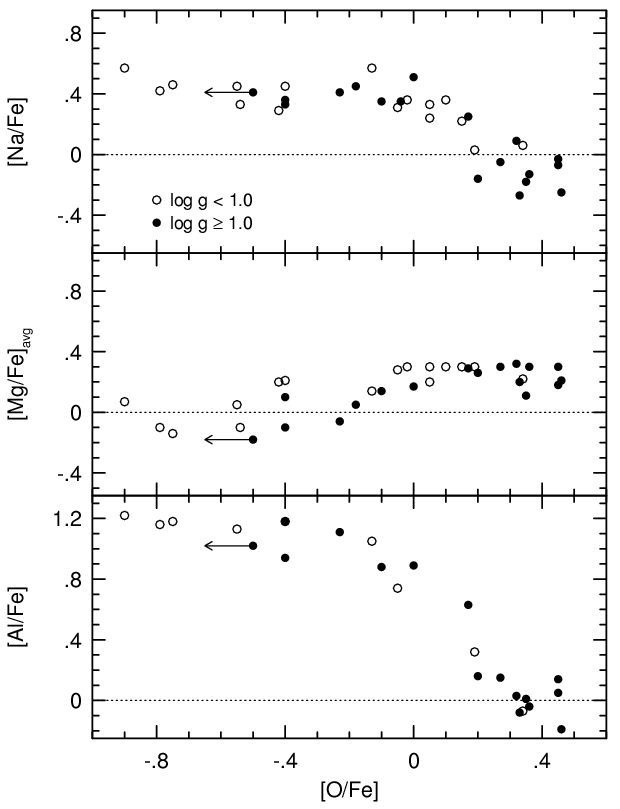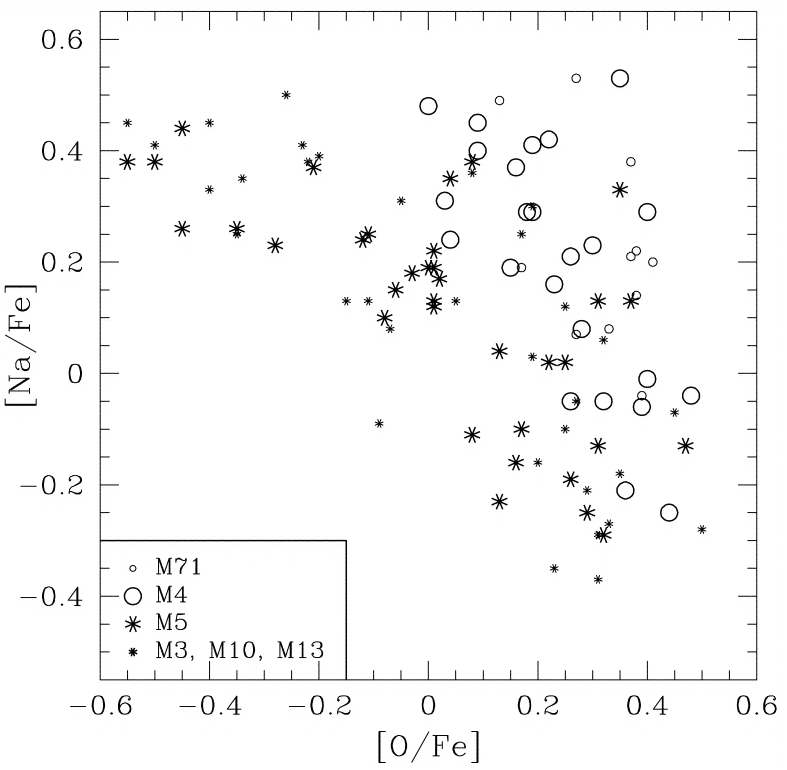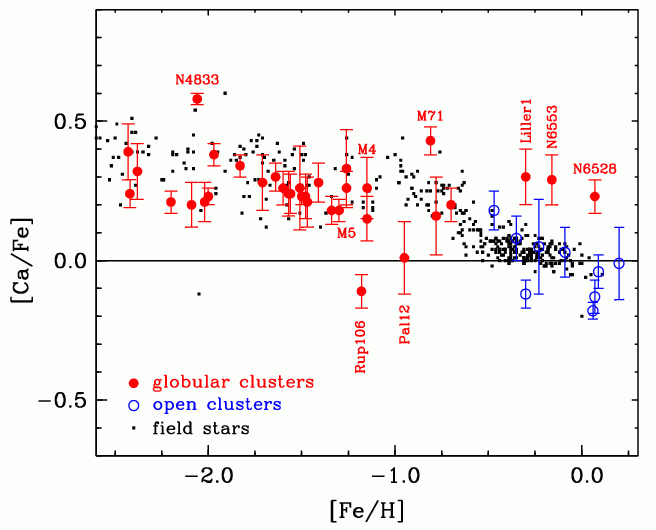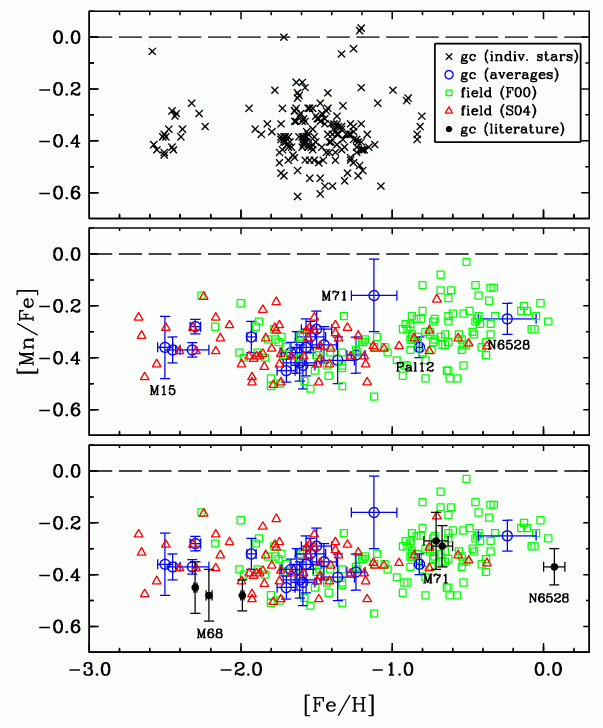CHEMICAL COMPOSITIONS OF HALO STARS
HOME |
TEACHING |
RESEARCH |
LABDATA |
MOOG |
SPECTRE |
MISC
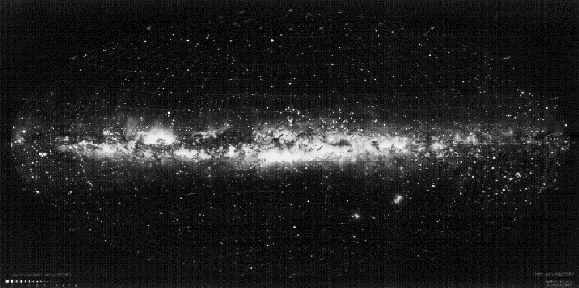
|
|
The elements of the periodic table do not just magically exist! They have been created, mostly in nuclear fusion reactions that occur in the extremely hot and dense interiors of stars. Each star generates heavy elements and returns them to the interstellar medium as it dies. Thus the overall metal content of our Galaxy has grown with time. But our knowledge of elemental nucleosynthesis is far from complete, so much so that a panel of the National Research Council's board on physics and astronomy named "How were the heavy elements from iron to uranium made?" as number three in their list of The 11 Greatest Unanswered Questions of Physics.
|

|
The record of our Milky Way Galaxy's initial burst of element generation is contained in the chemical compositions of metal-poor stars of the Galactic halo. I am involved in several related efforts to apply high resolution, high S/N spectroscopy to the determination of abundances in stars with metallicities ranging over three orders of magnitude. Here I briefly discuss a few aspects of these projects, These results are products of the collective efforts of my friends who are co-authors on the various papers, and I am pleased to acknowledge the support of the US National Science Foundation and NASA in all of these studies.
Neutron-Capture Elements: the r-Process
Neutron-capture elements are those whose major isotopes are created in nuclear fusion regions via the ingestion of free neutrons by lighter seed nuclei (such as Fe, for example). The neutron-capture elements defined in this way comprise essentially all elements of the periodic table with atomic numbers greater than 30, thus comprising nearly two-thirds of the stable elements in the periodic table.
Neutron-capture and beta-decay rates compete with each other in building the neutron-capture elements. Low neutron fluxes (the so-called s-process) create unstable nuclei that undergo beta-decays between successive neutron captures, and element synthesis proceeds along the valley of beta-stability. High neutron fluxes (the r-process) create extremely heavy isotopes of nuclei (up to the neutron-drip line) that then rapidly decay back toward the valley of β-stability after the cessation of the neutron flux. The s-process occurs during quiet stellar evolution (such as during helium burning), while the very violent r-process is associated in some way with the explosive deaths of high-mass stars in Type II supernovae.
The most metal-poor of our Galaxy's stars exhibit enormous variations in their bulk contents of neutron-capture elements, as a glance at the following picture will show.
Our studies have shown that the dominant mode of neutron-capture element production in CS 22892-052 and many other halo stars was the r-process. This is illustrated in the elemental abundance plot shown here from Sneden et al. 2003). There is a very nice match to the expected abundance distribution from the r-process, but no match at all to an s-process pattern. This indicates the dominance of explosive synthesis of the neutron-capture elements in the early Galactic history.
The very heavy neutron-capture element thorium (Th) is created only via the r-process, but it is radioactively unstable, decaying with a half-life of 14 billion years. This element has been detected in a lot of very metal-poor, r-process-rich stars. In the above figure, the relative abundance of thorium to the other neutron-capture elements less than predicted, because as time has gone on thorium has decayed away. This yields an "age" for Th and other neutron-capture elements of about 15 billion years, possibly providing an independent age estimate for the halo of our Galaxy. For a general discussion of this work, please see my interview by StarDate writer Rebecca Johnson in 2002 (copyright University of Texas at Austin). For a technical summary of our r-process abundance studies in halo metal-poor stars, please see Cowan & Sneden (2003, Nature, 440, 1151). A selected list of other papers emphasizing the nucleosynthetic interpretation of these abundance results may be found John Cowan's website.
Neutron-Capture Elements: the s-Process
In the Galactic halo live many "blue metal-poor" (BMP) stars. These are stars that are on the main sequence but are bluer and more luminous than the normal stars of the main-sequence turnoff. If they are as old as the rest of the Galactic halo, BMP stars should have long-since evolved away from the main sequence. George Preston discovered (2000, AJ, 120, 1014) that about 2/3 of BMP stars are spectroscopic binaries, ones with long orbital periods but very low eccentricities (that is, nearly circular orbits). The simplest conclusion is that BMP stars that we see today are past victims of substantial mass transfer from companions that now are compact objects. The mass transfer happened during the expansion of the companion envelopes during their red-giant branch (RGB) or asymptotic giant branch (AGB) phases.
Further proof of this scenario has come from chemical composition studies of BMP stars. We discovered (Sneden, Preston, & Cowan 2003, ApJ, 592, 504) that several of the most metal-poor BMP binaries have greatly enhanced neutron-capture abundances with a distinct s-process distribution. The heaviest elements in the s-process chain, lead (PB) and bismuth (Bi) were discovered in one BMP star, as the following illustration shows.
Detailed comparisions with predicted s-process abundance distributions confirm its dominance in BMP binaries, as illustrated in the nex figure.
Globular Cluster Abundances
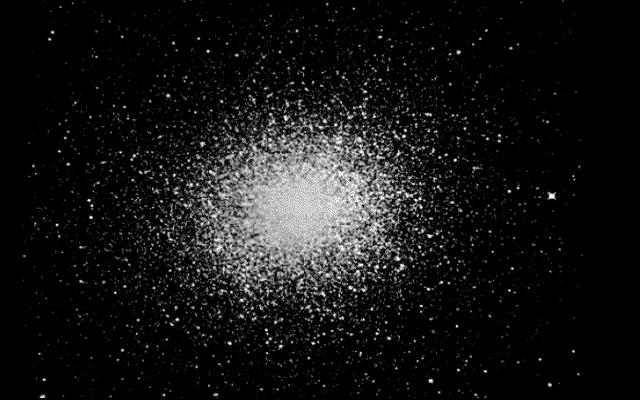
|
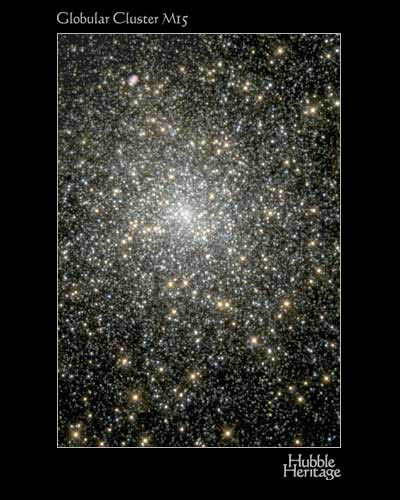
|
The elemental abundance patterns of globular cluster stars exhibit a rich (and often bewildering) variety. Very large star-to-star and cluster-to-cluster abundance differences are the rule, not the exception. The light elements of the periodic table (those elements with atomic numbers 13 or less) have the most obvious variations. The abundances of elements C, N, O, Na, Mg, and Al can be different in otherwise very similar giant stars of a single globular cluster. Fortunately, these abundances do not vary at random, but instead are interlinked in various correlations and anticorrelations. But some stars will have relatively large abundances of O and Mg and small abundances of Na and Al, while other stars will show the opposite abundance pattern. Good examples are the plots shown in the diagrams below.
A simple nucleosynthetic scenario covers many of the observed light element variations: very high temperature (up to 80 million degrees Kelvin) hydrogen fusion cycles. At the same high interior temperatures in which O can be converted to N in the ON-cycle hydrogen burning, spectroscopically undetectable) Ne can and will be turned into Na The anticorrelation between O and Na therefore occurs quite naturally, and the difference between high O, low Na stars and low O, high Na stars is that the latter stars have had a combination of higher interior temperatures and better convective envelope mixing than have the former stars. Recent studies suggest that this is a too simplistic idea. An alternate possibility suggests that earlier generations of cluster stars (now dead) seeded the intra-cluster medium with their elemental output, and the presently observed stars gathered in this material at birth. Probably both mechanisms are valid, but we do not know yet their relative roles. Please see, for example, the recent review of Gratton et al. (2004, Ann. Rev. Ast. Ap., 42, 385) for an extended discussion.
Equally intriguing is the clear connection between abundances of non-volatile heavier elements in globular cluster stars and members of the general halo field. To date, no differences between these two populations have been discovered in the so-called α and the Fe-peak elements, as we illustrate here:
This suggests that the major production of these elements either is finely tuned to the overall metallicities of high-mass progenitor stars, or that generation of these elements in the Galactic halo occured prior to the formation of the globular clusters that we see today.



